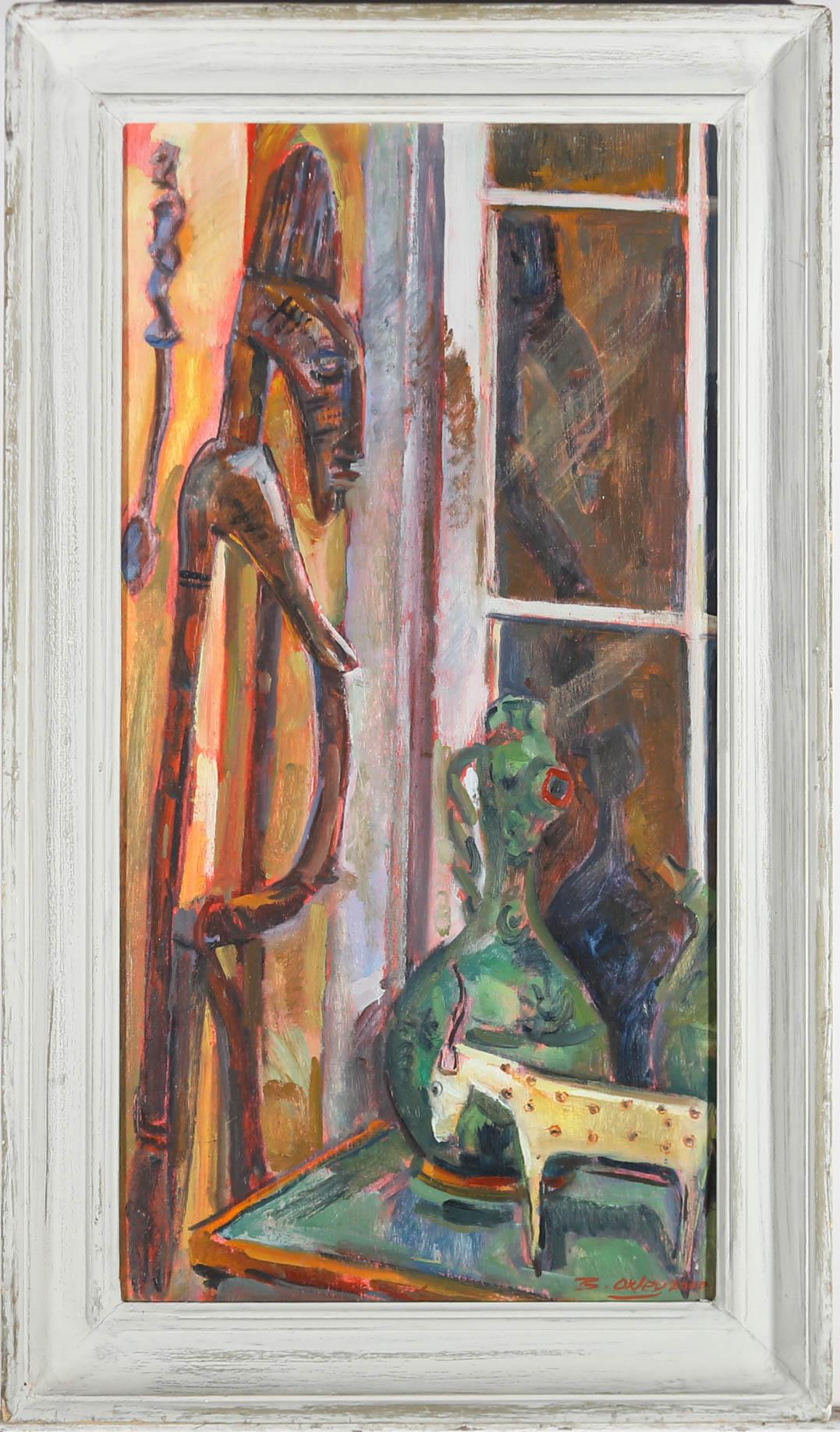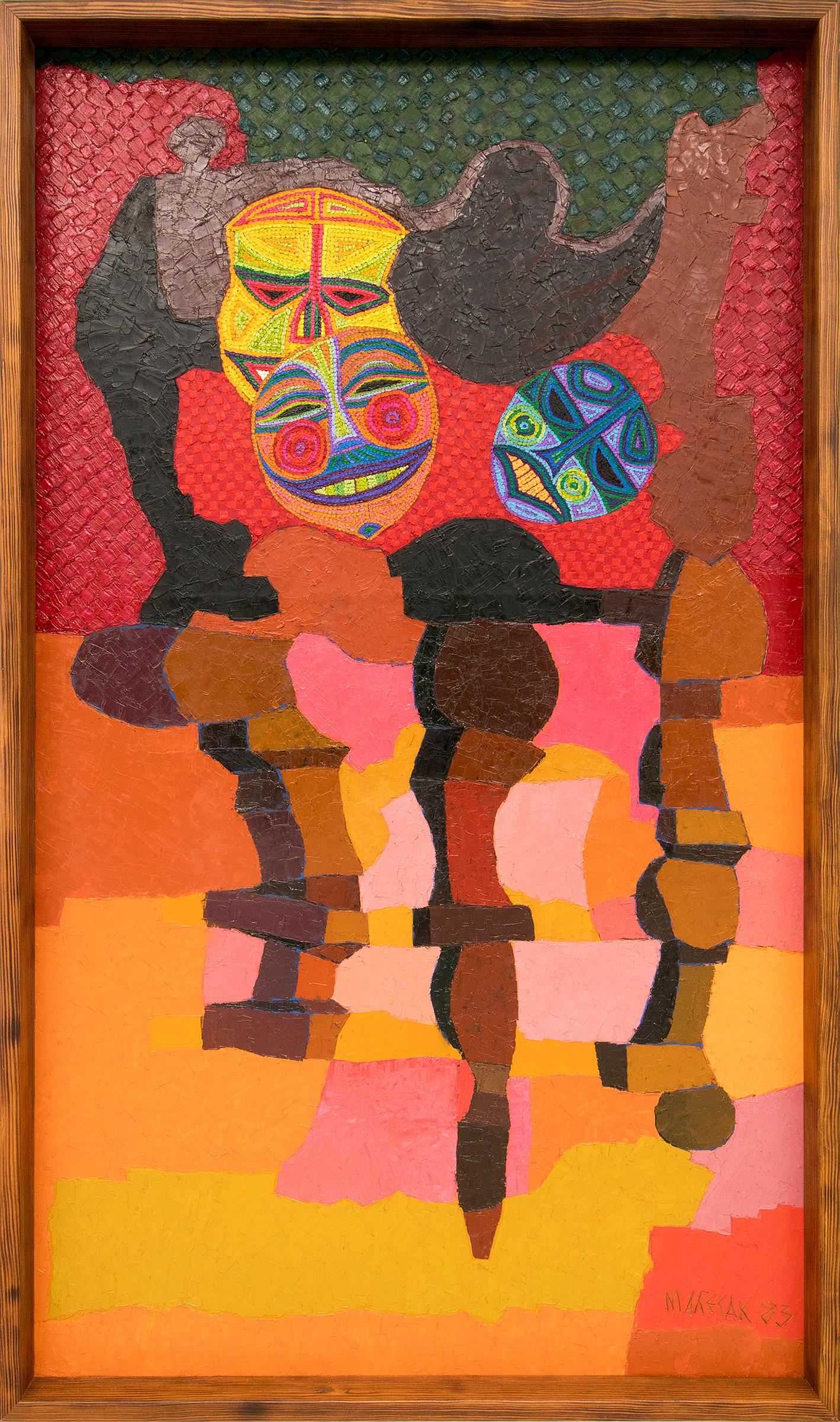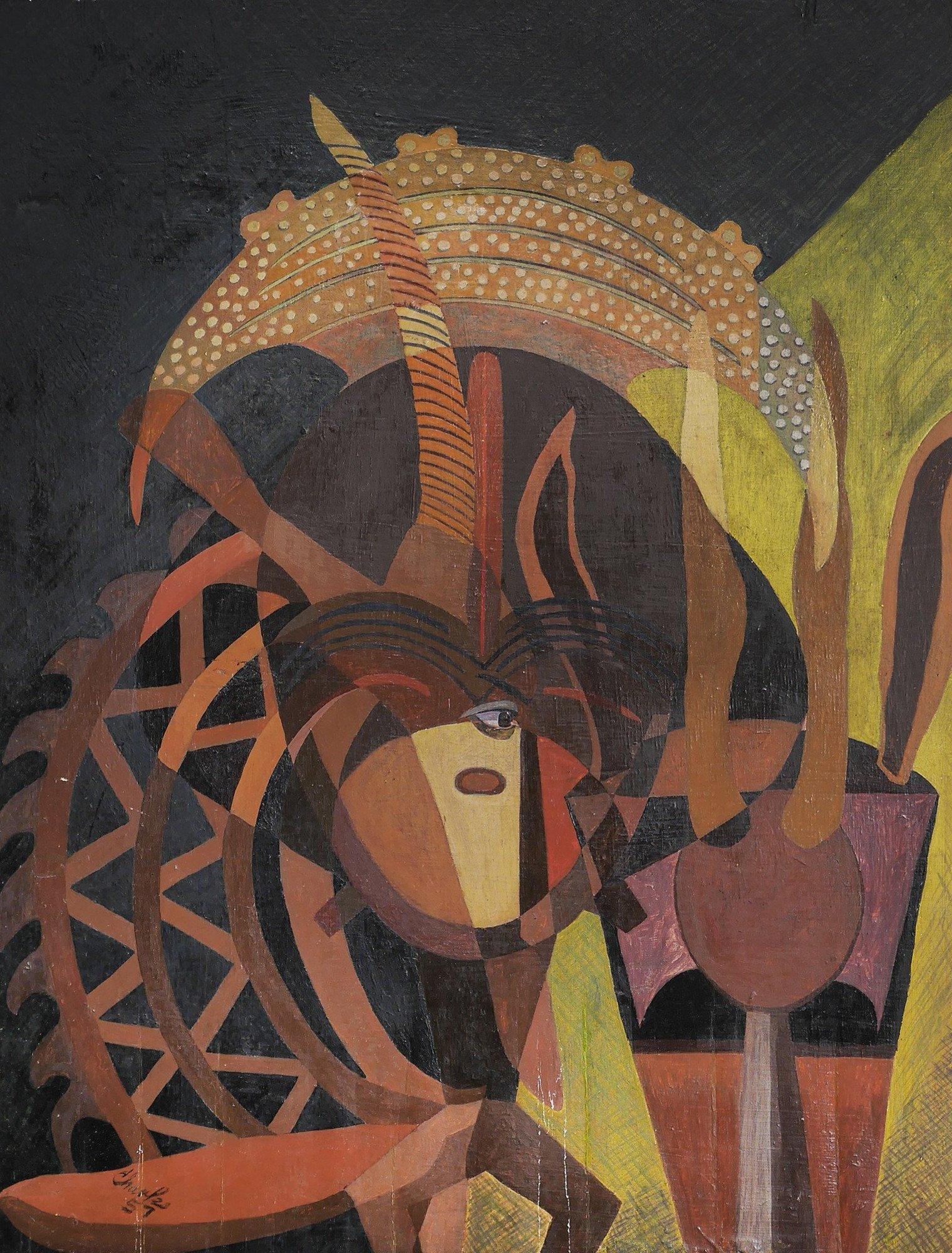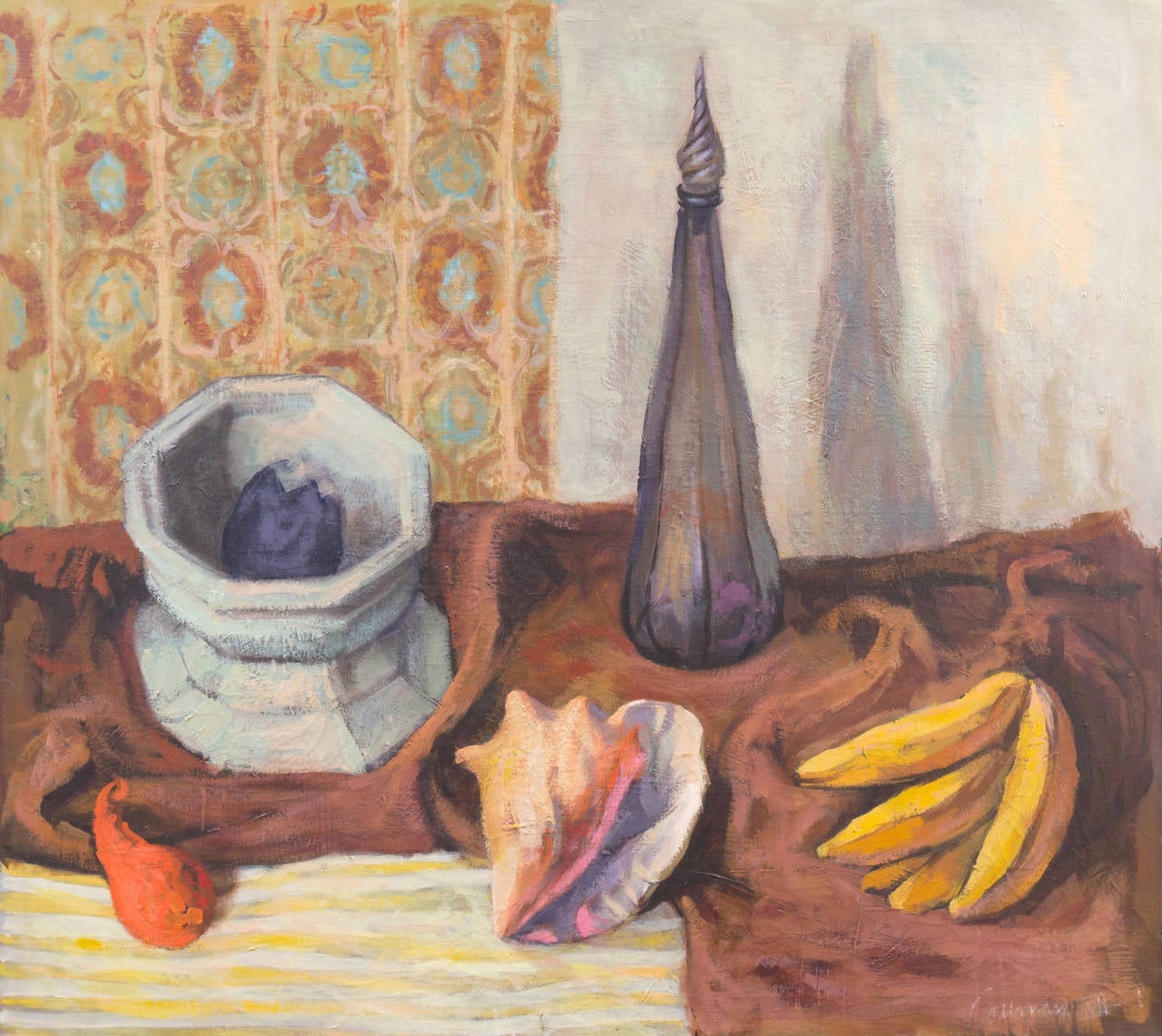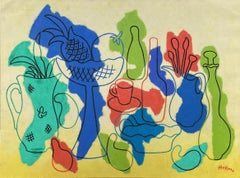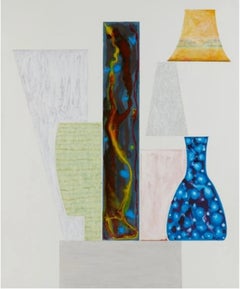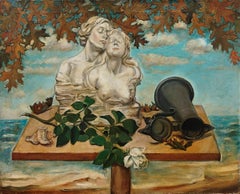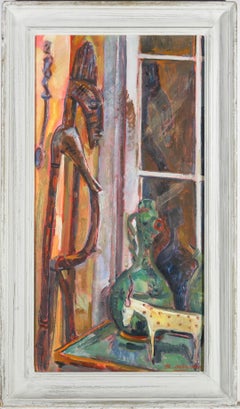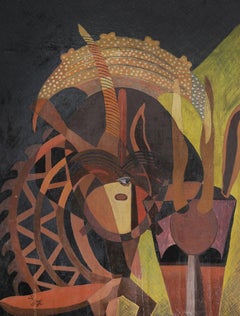Items Similar to "Ethnographic Still Life, " Edith Kramer, African Mask and Shofar, Art Therapy
Want more images or videos?
Request additional images or videos from the seller
1 of 8
Edith Kramer"Ethnographic Still Life, " Edith Kramer, African Mask and Shofar, Art Therapy
$3,200
$4,00020% Off
£2,407.07
£3,008.8420% Off
€2,774.55
€3,468.1920% Off
CA$4,507.55
CA$5,634.4420% Off
A$4,945.86
A$6,182.3320% Off
CHF 2,588.43
CHF 3,235.5420% Off
MX$60,866.79
MX$76,083.4920% Off
NOK 32,610.38
NOK 40,762.9720% Off
SEK 30,544.48
SEK 38,180.6020% Off
DKK 20,717.29
DKK 25,896.6120% Off
About the Item
Edith Kramer (1916 - 2014)
Still Life with Mask, n.d.
Oil on canvas
26 x 20 inches
Signed and titled on the stretcher
Provenance:
Estate of the artist
Kramer was born in Vienna, Austria-Hungary in 1916. At age 13 Kramer began art lessons with Friedl Dicker. Dicker was graduate of the Bauhaus in Weimar, Germany and was an artist and art teacher of note. Kramer studied drawing, sculpture and painting, and was influenced by the method for teaching art developed by Bauhaus artist Johannes Itten. It was in 1934 after Kramer graduated from Realgymnasium that she, then 18, followed Dicker to Prague to continue to study under her. During this time in Prague, Kramer witnessed the therapeutic impact of art when she assisted Dicker in teaching art to the children of political refugees.
With the threat of Nazi invasion looming, Kramer took refuge in America in 1938. In New York City, she worked for three years teaching sculpture at a progressive school called the Little Red School House. During World War II Kramer worked as a machinist at a tool and die shop in the Soho district of New York City. She stayed after her shift to draw the other workers in their industrial setting. These works were rendered in the social realist style. In 1947 Kramer visited some of the earliest known artwork, in the caves at Lascaux. Kramer spoke of these cave paintings as an example of the universal language of art.
At the age of 33 she returned to New York City, with hopes of making a living as an artist. Still in her 33rd year, Kramer was offered a job at Wiltwyck School for Boys, a school and residential treatment facility for children with behavioral and emotional needs. This job was arranged for her by psychoanalyst and board member at Wiltwyck, Dr. Viola Bernard. Dr. Bernard gave Kramer the title, "Art Therapist," noting that few teachers were willing to work with such challenging students. It was here that Kramer worked with disturbed boys, ages 8 through 13, for the following seven years.
Raised in a family which was interested in psychoanalytic theory, Kramer herself became a follower of Sigmund Freud. Kramer especially believed in the concept of sublimation. Freudian theory describes sublimation as a process in which primitive urges coming from the id are transformed into socially productive activities that lead to gratification of the original urge. Kramer's training was in art, art education and psychoanalytically informed psychotherapy. Kramer believed sublimation to be one of the most vital goals of art therapy. Through art, she believed, negative and destructive emotions and urges are transformed into useful products. Kramer asserted that the success of the therapy could be measured by the visual product.
Though Kramer and her fellow pioneer of American art therapy, Margaret Naumburg, had a similar goal of combining art and psychology, their beliefs took a different path where Kramer began to declare that it was art as therapy, and Naumburg instead promoted art in therapy.
Kramer's life work was spent with children and adolescents that were often unable to explain their feelings through the use of words. In 1958 Kramer published Art Therapy in a Children's Community, based on her time working with the students at the Wiltwyck School. Kramer also worked at Jacobi Hospital in their child psychiatric ward for 13 years. In 1971 Kramer published Art as Therapy with Children. Kramer wrote in her books of her experiences with her clients. Kramer worked for 14 years at the Jewish Guild for the Blind. In 1976 Kramer, with the help of Dr. Laurie Wilson, founded the graduate program in Art Therapy at New York University. While at NYU, Kramer came up with an important method of the program and called it, “the Art Therapist third hand intervention.” This concept called for the versatility of the art therapist. "The third hand can be summed up as the art therapist's ability to facilitate a person's artistic process (such as strategically helping the individual mix paints for a desired color or intervening at critical moments during art making)". It is important to note that Kramer believed that product was as important as process in Art Therapy. She felt denying the client the gratification of the end product was robbing them. Kramer believed that Art Therapy should fall more in the humanities area than psychology. She asserted that art therapy was not a replacement, but a supplement to psychotherapy.
When in active practice, Kramer maintained a studio where she painted, etched, and sculpted. Kramer believed that art should be personal and reflective of the artist's environment. She often depicted physical, tangible objects such as herself, other people, landscapes, and cityscapes. She preferred painting with expressive colors. Kramer argued that art therapists must make their own art in order to cope with "exhausting clinical work."
Edith Kramer became a U.S. citizen in 1944. Kramer received an honorary doctorate in 1996 from Norwich University in Northfield, Vermont. She helped develop one of the country's earliest art therapy graduate degree programs at New York University. She continued to work in NYU's Graduate Art Therapy Program from 1973 to 2005 as an adjunct professor and was an assistant professor in the Graduate Art Therapy Program at George Washington University in Washington, D.C. The American Art Therapy Association gave her the award of "Honorary Life Member,” a mark of highest esteem. Kramer eventually returned to her home in Austria. She died in 2014.
In 2014, Kramer was posthumously awarded the inaugural Myra Levick Award for Excellence in Art Therapy. The award was given "[f]or her role as an artist and art therapist whose ability to communicate with troubled children through art is a treasured legacy of a pioneer in our field. Her idea of art as therapy with her emphasis on the creative process itself as healing is a major contribution to art therapy theory".
- Creator:Edith Kramer (1916 - 2014, American, Austrian)
- Dimensions:Height: 32 in (81.28 cm)Width: 26 in (66.04 cm)
- Medium:
- Movement & Style:
- Period:
- Condition:Excellent.
- Gallery Location:New York, NY
- Reference Number:1stDibs: LU184129903942
About the Seller
5.0
Platinum Seller
Premium sellers with a 4.7+ rating and 24-hour response times
Established in 2022
1stDibs seller since 2022
121 sales on 1stDibs
Typical response time: <1 hour
- ShippingRetrieving quote...Shipping from: New York, NY
- Return Policy
Authenticity Guarantee
In the unlikely event there’s an issue with an item’s authenticity, contact us within 1 year for a full refund. DetailsMoney-Back Guarantee
If your item is not as described, is damaged in transit, or does not arrive, contact us within 7 days for a full refund. Details24-Hour Cancellation
You have a 24-hour grace period in which to reconsider your purchase, with no questions asked.Vetted Professional Sellers
Our world-class sellers must adhere to strict standards for service and quality, maintaining the integrity of our listings.Price-Match Guarantee
If you find that a seller listed the same item for a lower price elsewhere, we’ll match it.Trusted Global Delivery
Our best-in-class carrier network provides specialized shipping options worldwide, including custom delivery.More From This Seller
View All"Nature morte" Bela de Kristo, Mid-century Cubist Still Life Abstract Cello
By Bela De Kristo
Located in New York, NY
Bela de Kristo
Nature morte, circa 1956
Signed lower right
Oil on board
19 5/8 x 11 3/4 inches
Provenance:
Alexander Kahan Fine Arts, New York
Private ...
Category
1950s Cubist Still-life Paintings
Materials
Oil, Board
"Untitled" Albert Heckman, 1950s Modernist Abstracted Still Life Painting
By Albert Heckman
Located in New York, NY
Albert Heckman
Untitled, circa 1950
Signed lower right
Oil on canvas
21 1/4 x 29 inches
Albert Heckman was born in Meadville, Western Pennsylvania, 1893. He went to New York City to try his hand at the art world in 1915 after graduating from high school and landing a job at the Meadville Post Office. In 1917, at the age of 24, Heckman enrolled part-time in Teachers' College, Columbia University's Fine Arts Department to begin his formal art education. He worked as a freelance ceramic and textile designer and occasionally as a lecturer at the Metropolitan Museum of Art. In the early 1920s, at the age of almost 30, he graduated with a Bachelor of Arts degree from Columbia Teachers College. He was especially impacted by his instructor at Columbia, Arthur Wesley Dow.
After graduating, he was hired by the Teachers' College as a Fine Arts instructor. He stayed with Columbia Teachers' College until 1929, when he left to attend the Leipzig Institute of Graphic Arts in Leipzig, Germany. Isami Doi (1903-1965), who was born in Hawaii, was arguably his most impressive student at Columbia. Doi is now regarded as one of the most prominent artists hailing from Hawaii. Heckman became an active member and officer of the Keramic Society and Design Guild of New York in the 1920s as part of his early commercial art career. The Society's mission was to share knowledge and showcase textile and ceramic design exhibits.
In 1922, Heckman married Florence Hardman, a concert violinist. Mrs. Heckman's concert schedule during the 1920s kept Albert and Florence Heckman apart for a significant portion of the time, but they spent what little time they had together designing and building their Woodstock, New York, summer house and grounds. A small house and an acre of surrounding land on Overlook Mountain, just behind the village of Woodstock, were purchased by Albert and Florence Heckman at the time of their marriage. Their Woodstock home, with its connections, friendships, and memories, became a central part of their lives over the years, even though they had an apartment in New York City.
Heckman's main artistic focus shifted to the house on Overlook Mountain and the nearby towns and villages, Kingston, Eddyville, and Glasco. After returning from the Leipzig Institute of Graphic Arts in 1930, Mr. Heckman joined Hunter College as an assistant professor of art. He worked there for almost thirty years, retiring in 1956. Throughout his tenure at Hunter, Mr. Heckman and his spouse spent the summers at their Woodstock residence and the winters in New York City. They were regular and well-known guests at the opera and art galleries in New York. Following his retirement in 1956, the Heckmans settled in Woodstock permanently, with occasional trips to Florida or Europe during the fall and winter. Mr. Heckman's close friends and artistic career were always connected to Woodstock or New York City. He joined the Woodstock art group early on and was greatly influenced by artists like Paul and Caroline Rohland, Emil Ganso, Yasuo Kuniyoshi, Andre Ruellan, and her husband, Jack Taylor.
Heckman operated a summer art school in Woodstock for several years in the 1930s with support from Columbia University, where these and other Woodstock artists gave guest lectures. The Potter's Shop in New York City hosted Mr. Heckman's first art show in December 1928. The exhibit received some positive reviews from critics. The American Institute of Graphic Arts chose the plate of "Wehlen, Saxony" as one of the "Fifty Prints of the Year in 1929." There were sixteen etchings displayed. The remaining plates depicted scenes in Saxony, Germany, while five of the plates were based on scenes in Rondout, New York.
Heckman started switching from etching to black and white lithography by the early 1930s. A lifelong admirer of Heckman's artwork, Mr. Gustave von Groschwitz organized a significant exhibition of Heckman etchings and lithographs at the Ferargil Gallery in New York City in 1933. The exhibition traveled to the Stendahl Galleries in Los Angeles (May 1933), the Charles Lessler Gallery in Philadelphia (May 1933), J.L. Hudson in Detroit (June 1933), and Gumps in San Francisco (July 1933). Together with his early etchings, the exhibition featured brand-new black and white lithographs depicting scenes in and around Woodstock as well as "A View from Tudor City...
Category
1950s American Modern Figurative Paintings
Materials
Canvas, Oil
"Abstract (with Two White Vases) " Ed Baynard, Still Life Composition
By Ed Baynard
Located in New York, NY
Ed Baynard
Abstract (with Two White Vases), 2005
Signed, titled, and dated along the verso
Acrylic on canvas
48 x 40 inches
Category
Early 2000s Abstract Abstract Paintings
Materials
Canvas, Acrylic
"Untitled" Macena Barton, American, Surrealist Still Life, Sea Scape, Autumnal
Located in New York, NY
Macena Barton
Untitled
Signed lower right
Oil on canvas
24 x 30 inches
Provenance
Private Collection, California
Macena Alberta Barton was an American painter. Barton born in Uni...
Category
1930s Surrealist Still-life Paintings
Materials
Canvas, Oil
"Untitled" Albert Heckman, Still Life, Floral Abstracted Modernist Composition
By Albert Heckman
Located in New York, NY
Albert Heckman
Untitled, circa 1950
Signed lower right
Oil on canvas
25 1/4 x 32 1/4 inches
Albert Heckman was born in Meadville, Western Pennsylvania, 1893. He went to New York City to try his hand at the art world in 1915 after graduating from high school and landing a job at the Meadville Post Office. In 1917, at the age of 24, Heckman enrolled part-time in Teachers' College, Columbia University's Fine Arts Department to begin his formal art education. He worked as a freelance ceramic and textile designer and occasionally as a lecturer at the Metropolitan Museum of Art. In the early 1920s, at the age of almost 30, he graduated with a Bachelor of Arts degree from Columbia Teachers College. He was especially impacted by his instructor at Columbia, Arthur Wesley Dow.
After graduating, he was hired by the Teachers' College as a Fine Arts instructor. He stayed with Columbia Teachers' College until 1929, when he left to attend the Leipzig Institute of Graphic Arts in Leipzig, Germany. Isami Doi (1903-1965), who was born in Hawaii, was arguably his most impressive student at Columbia. Doi is now regarded as one of the most prominent artists hailing from Hawaii. Heckman became an active member and officer of the Keramic Society and Design Guild of New York in the 1920s as part of his early commercial art career. The Society's mission was to share knowledge and showcase textile and ceramic design exhibits.
In 1922, Heckman married Florence Hardman, a concert violinist. Mrs. Heckman's concert schedule during the 1920s kept Albert and Florence Heckman apart for a significant portion of the time, but they spent what little time they had together designing and building their Woodstock, New York, summer house and grounds. A small house and an acre of surrounding land on Overlook Mountain, just behind the village of Woodstock, were purchased by Albert and Florence Heckman at the time of their marriage. Their Woodstock home, with its connections, friendships, and memories, became a central part of their lives over the years, even though they had an apartment in New York City.
Heckman's main artistic focus shifted to the house on Overlook Mountain and the nearby towns and villages, Kingston, Eddyville, and Glasco. After returning from the Leipzig Institute of Graphic Arts in 1930, Mr. Heckman joined Hunter College as an assistant professor of art. He worked there for almost thirty years, retiring in 1956. Throughout his tenure at Hunter, Mr. Heckman and his spouse spent the summers at their Woodstock residence and the winters in New York City. They were regular and well-known guests at the opera and art galleries in New York. Following his retirement in 1956, the Heckmans settled in Woodstock permanently, with occasional trips to Florida or Europe during the fall and winter. Mr. Heckman's close friends and artistic career were always connected to Woodstock or New York City. He joined the Woodstock art group early on and was greatly influenced by artists like Paul and Caroline Rohland, Emil Ganso, Yasuo Kuniyoshi, Andre Ruellan, and her husband, Jack Taylor.
Heckman operated a summer art school in Woodstock for several years in the 1930s with support from Columbia University, where these and other Woodstock artists gave guest lectures. The Potter's Shop in New York City hosted Mr. Heckman's first art show in December 1928. The exhibit received some positive reviews from critics. The American Institute of Graphic Arts chose the plate of "Wehlen, Saxony" as one of the "Fifty Prints of the Year in 1929." There were sixteen etchings displayed. The remaining plates depicted scenes in Saxony, Germany, while five of the plates were based on scenes in Rondout, New York.
Heckman started switching from etching to black and white lithography by the early 1930s. A lifelong admirer of Heckman's artwork, Mr. Gustave von Groschwitz organized a significant exhibition of Heckman etchings and lithographs at the Ferargil Gallery in New York City in 1933. The exhibition traveled to the Stendahl Galleries in Los Angeles (May 1933), the Charles Lessler Gallery in Philadelphia (May 1933), J.L. Hudson in Detroit (June 1933), and Gumps in San Francisco (July 1933). Together with his early etchings, the exhibition featured brand-new black and white lithographs depicting scenes in and around Woodstock as well as "A View from Tudor City...
Category
1950s Abstract Figurative Paintings
Materials
Canvas, Oil
"A Martinique Native in French Guyana, " Black Female Portrait, Female Artist
Located in New York, NY
May Mott Smith (1879 - 1952)
A Martinique Native in French Guiana, circa 1925
Watercolor on paper
24 x 20 inches
Signed lower right; titled on the reverse
“Martinique Native” is an ...
Category
1920s Feminist Portrait Drawings and Watercolors
Materials
Paper, Watercolor
You May Also Like
African Mask
By Raymond Bailly
Located in Houston, TX
Bold French still life painting of small African mask on warm brown and blue background by artist Raymond Bailly, circa 1965.
Original artwork on p...
Category
1960s Still-life Paintings
Materials
Acrylic
Brian Oxley (b.1943) - 2000 Oil, Still Life of Indigenous Objects
Located in Corsham, GB
A delightful still life study capturing an assortment of indigenous objects placed on a windowsill. The artist captures the scene in bright colours and an expressive style, paying pa...
Category
21st Century and Contemporary Still-life Paintings
Materials
Oil
$504 Sale Price
20% Off
Edward Marecak “Still Life with Masks” 1983 Semi-Abstract Denver Modernist
By Edward Marecak
Located in Denver, CO
This striking semi-abstract still life painting titled “Still Life with Masks” was created in 1983 by Denver modernist Edward Marecak (1919–1993). Executed in bold oil on board, the ...
Category
1980s American Modern Abstract Paintings
Materials
Oil
Meditation on African Sculpture, mid-century figural abstract painting
By Beni E. Kosh
Located in Beachwood, OH
Beni E. Kosh/Charles Elmer Harris (American, 1917-1993)
Meditation on African Sculpture, 1957
Oil on found wood panel
Signed and dated lower left
20 x 15 inches
Charles Elmer Harris...
Category
1950s Modern Abstract Paintings
Materials
Oil
'Still Life with Conch Shell', Large Mid-Century American Post Impressionist Oil
By Callanan
Located in Santa Cruz, CA
A substantial, Post-Impressionist oil still-life showing a view of various objects including fruit, a glass bottle and a sea-shell assembled on a draped table-top. A dynamic and vibr...
Category
1960s Post-Impressionist Still-life Paintings
Materials
Canvas, Oil
Large Indigenous Mask
By Raymond Bailly
Located in Houston, TX
Dramatic still life painting of large indigenous mask on blue background by French artist Raymond Bailly, circa 1965.
Original artwork on paper displa...
Category
1960s Still-life Paintings
Materials
Acrylic
More Ways To Browse
Ethnographic Art
Weimar Germany
20th Century Africa Paintings
Freud Sigmund
Edith Brown
F D Ward
Machinist Tools Used
Framed Serigraphs
Lithographs Dancing
Miro 1960
Original Maeght Prints
Hand Signed Numbered Lithograph Limited Edition
1972 Print
Leger Mourlot
Mexican Lithograph
Original Lithograph 1950s
19th Century Etchings
German Print Early 20th Century
